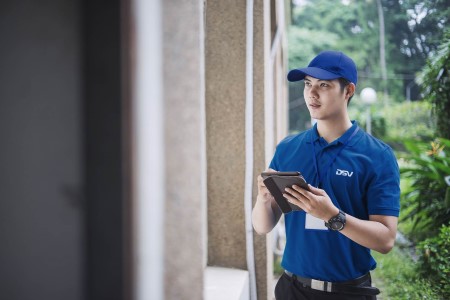How technology is transforming door-to-door delivery services
Introduction
In recent years, the logistics sector has witnessed unprecedented growth, spurred by technological advancements that have reshaped traditional door-to-door delivery services. As eCommerce continues to soar, the demand for faster, more reliable delivery options has become paramount. This blog explores how cutting-edge technologies are revolutionising the way parcels and packages are handled from dispatch to doorstep, ensuring efficiency and enhancing customer satisfaction in the process.

The role of automation in streamlining operations
Automation has become a cornerstone in modern logistics, significantly improving the speed and accuracy of operations within the delivery industry. Automated sorting systems, for instance, can process thousands of parcels per hour, categorising them by size, destination, and priority without human intervention. This not only speeds up the handling process but also reduces the likelihood of errors that can lead to delays and mis-deliveries. Furthermore, automated packaging technologies have evolved to adapt to various product types, securely packaging items in tailor-fitted materials that minimise damage and waste during transit.
The integration of advanced robotics in warehouses is another leap forward. These robots are equipped to retrieve items from shelves and prepare them for shipping, which optimises warehouse operations and frees human workers to focus on more complex tasks. The synergy between human labour and robotic assistance is creating a more dynamic workflow that maximises productivity and operational efficiency.
Real-time tracking systems
The advent of real-time tracking systems has transformed customer expectations and experience in parcel delivery. Modern GPS technology enables precise tracking of delivery vehicles, allowing both senders and recipients to view the exact location of their items in real-time. This transparency helps in managing expectations and improves customer service by providing accurate delivery times.
Moreover, these systems offer logistics companies critical data to monitor and analyse their delivery routes and times, identifying patterns and obstacles that could affect efficiency. Such insights are invaluable in refining the logistics process, ensuring faster delivery times and reduced operational costs, ultimately leading to improved customer satisfaction and loyalty.
The impact of AI on route optimisation
Artificial intelligence (AI) plays a pivotal role in enhancing the efficiency of delivery routes through sophisticated algorithms that analyse vast amounts of data on traffic patterns, weather conditions, and delivery schedules. AI-driven route optimisation tools suggest the quickest, most cost-effective routes in real-time, allowing drivers to avoid delays caused by roadworks, congestion, or adverse weather conditions.
These AI systems continuously learn and adapt, improving their predictions over time to ensure optimal performance. By minimising travel time and fuel consumption, route optimisation not only enhances operational efficiency but also contributes to the environmental sustainability of delivery operations, aligning with global efforts to reduce carbon footprints in the logistics sector.
Drone delivery: The next frontier
Drone delivery is one of the most futuristic aspects of modern logistics, offering a glimpse into a world where goods are delivered swiftly through the sky. Trials and implementations of drone delivery systems around the world have demonstrated the potential to drastically reduce delivery times, particularly in congested urban areas or remote locations where traditional delivery methods are less efficient.
The use of drones also presents a significant reduction in human labour and vehicular traffic, which could lead to a decrease in delivery costs and environmental impact. Although regulatory and safety issues still need to be addressed comprehensively, the potential for drones to supplement traditional delivery methods in the near future is immense, promising a faster, more efficient service.
The rise of robotic delivery services
Robotic delivery services represent another technological innovation that is set to transform urban delivery landscapes. These autonomous delivery robots can navigate sidewalks and pedestrian areas to deliver goods directly to consumers' doorsteps. In cities where traffic congestion can significantly delay traditional delivery methods, robots offer an efficient and cost-effective alternative.
Apart from enhancing delivery speed, these robots are designed to secure the parcels until they reach the correct recipient, using secure compartments that can only be opened with a code sent to the customer's mobile device. This level of security ensures that packages are not only delivered efficiently but also safely, reducing the risk of theft or loss.
Enhanced security features
Security is a major concern in the delivery industry, and technology has been pivotal in addressing these challenges. Innovative security features such as biometric authentication, electronic locking systems, and tamper alerts have been integrated into the logistics process to ensure that parcels are protected throughout their journey.
These technologies not only safeguard against unauthorised access but also provide a traceable, transparent pathway from sender to receiver. Furthermore, many logistic companies now employ sophisticated encryption methods to secure data exchanged during the delivery process, such as tracking information and customer details, protecting them from cyber threats.
The enhancement of security features also extends to the physical handling of parcels. For instance, sensor-based technology can detect and record conditions such as temperature, humidity, and shocks throughout the transport process. This is particularly crucial for sensitive items like pharmaceuticals or perishable goods, ensuring they are maintained in optimal conditions and reach their destination in perfect state.
Green technology in logistics
As the global call for sustainability intensifies, the logistics sector is turning to green technology to minimise its environmental impact. Electric delivery vehicles are at the forefront of this shift, significantly reducing the emissions associated with diesel or petrol-powered trucks. Companies are increasingly integrating electric vans and trucks into their fleets, especially for urban deliveries where shorter routes allow for regular recharging.
Additionally, the push towards sustainable practices has led to innovations in packaging. Biodegradable packing materials are becoming increasingly popular, replacing plastics and other non-sustainable options. These materials decompose naturally, reducing waste and environmental footprint. Furthermore, optimisation software also contributes to sustainability by reducing the number of vehicles on the road and improving load efficiency, thus decreasing the overall carbon emissions per delivery.
Customisation through technology
Technology has enabled a high degree of customisation in delivery services, which can be tailored to meet specific customer preferences and requirements. Digital platforms now allow customers to select preferred delivery slots, choose locations for package drop-off, and even modify delivery instructions in real-time. This level of customisation not only enhances customer satisfaction but also improves the efficiency of the delivery process by reducing missed deliveries and the need for re-deliveries.
The role of technology in facilitating such customisation extends beyond mere scheduling. Advanced systems are capable of handling complex logistical tasks, such as adjusting delivery routes and schedules dynamically in response to customer changes or external factors like traffic or weather conditions. This flexibility is a key advantage in today’s fast-paced market, where consumer preferences and circumstances can change rapidly.
The integration of IoT in delivery services
The Internet of Things (IoT) has become integral to enhancing logistical operations, connecting various elements of the delivery process for improved coordination and efficiency. IoT devices in warehouses, for example, can monitor inventory levels, track goods as they move through the supply chain, and even predict maintenance needs for equipment to prevent downtime.
On the delivery end, IoT technology facilitates better communication between vehicles, delivery personnel, and operational centres. This connectivity ensures that all parties are informed in real-time about the status of deliveries, any potential issues, and changes in the schedule or route. Such integration leads to a more cohesive operation, reducing delays and improving response times to unforeseen events.
Mobile applications and customer engagement
Mobile applications are revolutionising the way customers interact with delivery services. These apps provide users with intuitive interfaces to track their deliveries, receive updates, and access customer service with ease. The instant availability of information and the ability to interact directly with service providers have greatly enhanced the user experience, fostering greater customer engagement and satisfaction.
Moreover, these applications often include features such as delivery confirmation, photo capture of where packages are left, and real-time feedback mechanisms. Such features not only improve the security and reliability of deliveries but also empower customers to have a more active role in the delivery process. This increased engagement helps companies build trust and loyalty with their customers, which is crucial in a competitive market.
Conclusion
The integration of technology into door-to-door delivery services is transforming the industry, making it faster, more efficient, and customer-friendly. From automation and AI in operational processes to the use of drones and robots for delivery, technology is at the forefront of this revolution. As these technologies continue to evolve and mature, the future of delivery services looks promising, with enhanced capabilities, reduced environmental impact, and unprecedented levels of service customisation and customer satisfaction.
